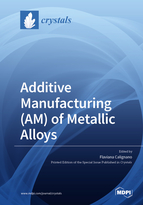Additive Manufacturing (AM) of Metallic Alloys
A special issue of Crystals (ISSN 2073-4352). This special issue belongs to the section "Inorganic Crystalline Materials".
Deadline for manuscript submissions: closed (31 May 2020) | Viewed by 34662
Special Issue Editor
Interests: additive manufacturing; laser powder bed fusion process; design for additive manufacturing
Special Issues, Collections and Topics in MDPI journals
Special Issue Information
Dear Colleagues,
Developed in the 1980s, Additive Manufacturing (AM), known as Rapid Prototyping, has already revolutionized the production of polymeric material components. New developments in AM technologies are providing industries with the ability to build structural components with a variety of metal alloys, ceramics, and composite materials. The introduction of metal AM processes has revolutionized the production of metallic components in the industrial sectors where complex geometries, organic shapes, tubular, hollow designs, and dense, lattice-filled structures play a decisive role. In the AM, there is no correlation between complexity and cost. Sometimes, more complexity means lower costs: fewer materials and no need for assembly. However, there are problems that limit the wider uptake and exploitation of metals AM. These are related to the lack of design and modeling skills and AM software, to the different properties that are obtained using the same technology but different machines, to the difficulty in perfectly simulating the processes, to the incomplete understanding of the causes of the variation in the quality of the parts and to the repeatability of the processes. This Special Issue is dedicated to disseminating these scientific efforts.
It is my pleasure to invite you to submit full papers and reviews in the areas of material supply, part design, process modelling, process technology, postprocessing, and applications of metals AM.
Dr. Flaviana Calignano
Guest Editor
Manuscript Submission Information
Manuscripts should be submitted online at www.mdpi.com by registering and logging in to this website. Once you are registered, click here to go to the submission form. Manuscripts can be submitted until the deadline. All submissions that pass pre-check are peer-reviewed. Accepted papers will be published continuously in the journal (as soon as accepted) and will be listed together on the special issue website. Research articles, review articles as well as short communications are invited. For planned papers, a title and short abstract (about 100 words) can be sent to the Editorial Office for announcement on this website.
Submitted manuscripts should not have been published previously, nor be under consideration for publication elsewhere (except conference proceedings papers). All manuscripts are thoroughly refereed through a single-blind peer-review process. A guide for authors and other relevant information for submission of manuscripts is available on the Instructions for Authors page. Crystals is an international peer-reviewed open access monthly journal published by MDPI.
Please visit the Instructions for Authors page before submitting a manuscript. The Article Processing Charge (APC) for publication in this open access journal is 2600 CHF (Swiss Francs). Submitted papers should be well formatted and use good English. Authors may use MDPI's English editing service prior to publication or during author revisions.
Keywords
- Process simulation
- Design for AM
- Industrial applications
- Material and process design
- New materials and alloys
- Materials characterization
- Multimaterial AM
- Postprocessing (heat treatment, finishing, etc.)
- Process control, optimization, and quality assurance
- Standards for metal AM






